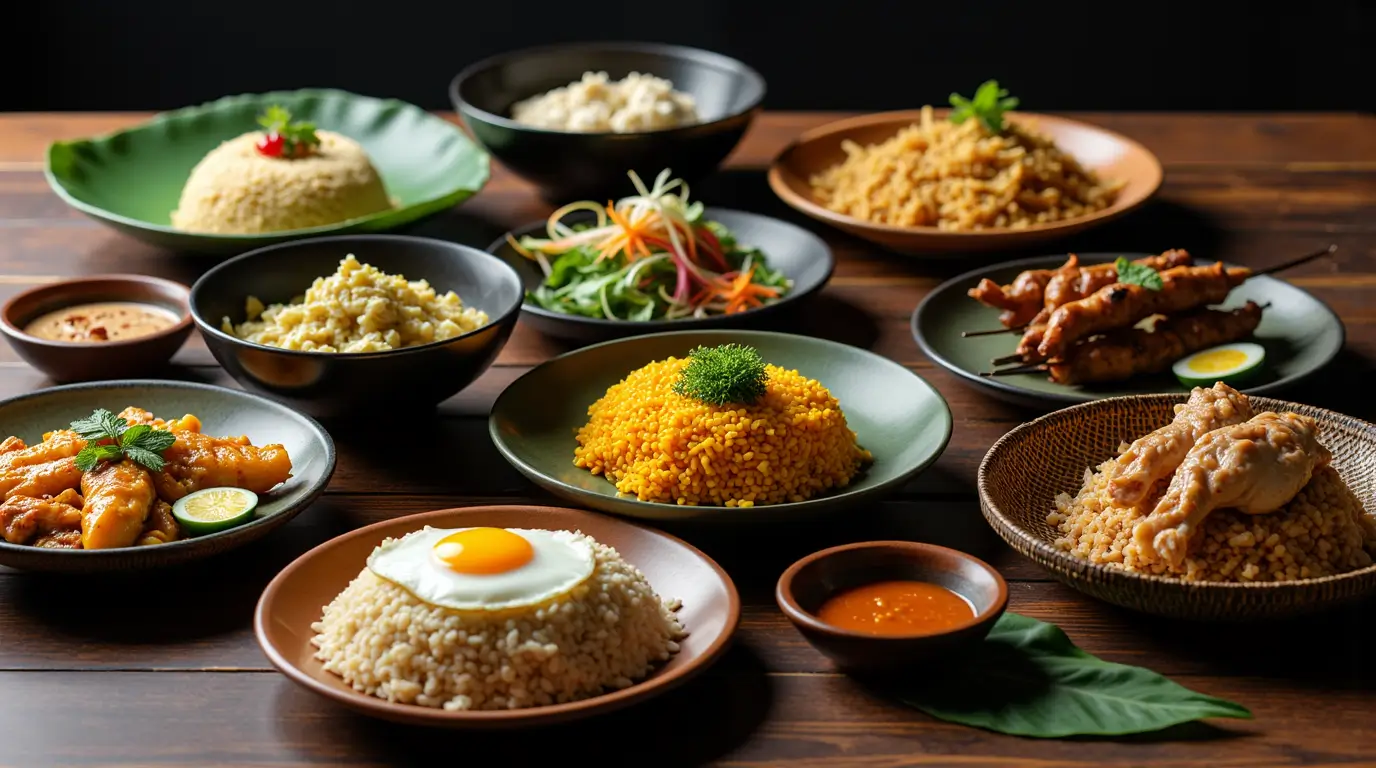Table of Contents
Table of Contents
Introduction
Indonesia is an archipelago nation of more than 17,000 islands—each with its own cultural identity, heritage, and flavors. This fascinating tapestry of geography and culture has given rise to one of the world’s most diverse and vibrant cuisines. From the aromatic street-food stalls of Jakarta to the traditional kitchens in rural Bali, Indonesian cuisine captivates diners with its bold spices, fresh ingredients, and centuries-old recipes. It’s a cuisine deeply rooted in Indonesia’s rich history, shaped by the influences of trade, colonization, and migration.
When people think of Indonesian food, well-known dishes like nasi goreng (fried rice), satay (seasoned, skewered, and grilled meat), and the internationally celebrated rendang (a rich, slow-cooked beef dish) often come to mind. However, these are just a small sample of the extensive culinary offerings waiting to be discovered. With each region showcasing distinct cooking methods, spices, and staple ingredients, Indonesian cuisine is as vast as the archipelago itself.
In this article, we will explore Indonesia’s gastronomic story—from the historical background and cultural context that shaped Indonesian Cuisine to the wide variety of signature ingredients fundamental to local dishes. You’ll learn about must-try classics, as well as the key features that make Indonesian food a draw for culinary enthusiasts seeking intense, layered flavors. We will delve into dining customs, etiquette, and table rituals, shedding light on the cultural significance behind every meal. Finally, we’ll look at modern trends and how chefs today are reinventing tradition for a new generation. By the end of this article, you’ll walk away with a deeper appreciation and a desire to sample these savory and sweet delights for yourself.
Culinary Context and History
Early Influences and the Spice Trade
Indonesia’s strategic location has always been its culinary blessing and curse. Long before European powers arrived, the archipelago was a significant stopover on the spice routes connecting Asia, the Middle East, and Europe. This positioning laid the foundation for Indonesian Cuisine, particularly in the Moluccas (often referred to as the “Spice Islands”), which were renowned for cloves, nutmeg, and mace. Arab, Chinese, and Indian merchants regularly docked at Indonesian ports to trade these prized commodities, leaving not only spices but also cultural and culinary influences.
From India came curry-like flavors and the use of various spices like cumin and coriander. Chinese settlers introduced stir-frying techniques, the penchant for noodles, and soy-based products such as tofu and soy sauce (kecap). Over time, Indonesian cooks adapted these influences, mixing them with local produce and condiments to create new flavor profiles that remain distinctive yet carry a trace of their foreign origins.
The Colonial Era
The arrival of European powers—Portuguese, Dutch, and the British—further shaped Indonesia’s gastronomic heritage. Of these, the Dutch left the longest-lasting impact, ruling parts of Indonesia (then the Dutch East Indies) for several centuries. During this period, European cooking methods like baking, roasting, and the incorporation of dairy products found their way into some Indonesian dishes. Conversely, Dutch cuisine also absorbed local flavors. Even today, in the Netherlands, you’ll find Indonesian-inspired items like rijsttafel (a lavish spread of Indonesian dishes served with rice) as part of the culinary landscape.
Colonial plantations also led to the proliferation of crops like coffee, cocoa, sugarcane, and rubber, further enriching Indonesian Cuisine. The adaptation of these new crops into the local diet brought about fusion dishes and fresh uses for these ingredients, bridging local cooking traditions and Western recipes. Sugarcane, for instance, played a part in the sweetening of certain Javanese dishes, while coffee plantations gave rise to unique local coffee cultures, especially in places like Aceh and Toraja.
Migration and Cultural Diversity
Migration played (and continues to play) a tremendous role in shaping Indonesian Cuisine. Chinese immigrants settled largely in urban centers and introduced not just stir-fry dishes, but also noodles and dumplings, which were localized and adapted with Indonesian spices. Meanwhile, Middle Eastern communities contributed aromatic spice blends, skewered meats, and celebratory rice dishes.
Each region in Indonesia has a distinct ethnic makeup that influences local cuisines, further enriching Indonesian Cuisine. For instance, the Minangkabau people of West Sumatra are known for their fiery chilies and coconut milk-based dishes, most famously rendang. In Bali, where Hindu cultural influences prevail, dishes feature fragrant spice pastes (base genep) and use pork as a signature meat—something you rarely see in predominantly Muslim parts of the archipelago. Meanwhile, in Maluku and Papua, sago often replaces rice as the primary starch, and seafood reigns supreme.
Regional Variations
- Sumatra (West, North, and South Sumatra): Dishes here tend to be spicier and richer, reflecting the use of chilies and coconut milk. The Padang cuisine of West Sumatra is particularly famous for dishes laid out buffet-style in small plates, giving diners a chance to sample a variety of curries and stews.
- Java (Central, East, and West Java): The island of Java, especially around Yogyakarta and Solo, is known for sweeter flavors that come from palm sugar and thick soy sauce (kecap manis). In East Java, dishes still have a kick but often incorporate a pleasing sweet-savory balance. West Java leans more on fresh vegetables and sour flavors.
- Bali and Nusa Tenggara: Balinese cuisine is distinct due to its Hindu cultural background. Traditional spice pastes feature turmeric, galangal, and lesser-known herbs like kencur (aromatic ginger). Nusa Tenggara’s food can be less sweet and sometimes more rustic, featuring goat meat and simpler chili-based sauces.
- Kalimantan (Borneo): Culinary traditions are tied to Dayak culture, which often includes wild forest vegetables, river fish, and indigenous cooking techniques like bamboo grilling.
- Sulawesi: Seafood is crucial here, especially along coastal regions. Manadonese cuisine (from North Sulawesi) is celebrated for its heat, courtesy of local chilies, and the bold use of ingredients like lemongrass and lime leaves.
- Maluku and Papua: Known for using sago as a staple, these eastern regions also incorporate an abundance of fresh fish and tropical produce like breadfruit and taro. Flavors can be smoky, and cooking methods are often simpler but highly flavorful.
The result of all these layers of history and geography is a cuisine that is both diverse and unified, showcasing the essence of Indonesian Cuisine. While each island and ethnic group has its own signature dishes and cooking styles, the use of aromatic spices, fresh herbs, and chili peppers creates a continuity of flavor that is unmistakably Indonesian.
Key Ingredients and Local Products
Essential Spices, Herbs, and Condiments
- Chili Peppers (Cabai): Chilies are ubiquitous in Indonesian cooking, coming in many forms—from the fiery bird’s eye chili to milder red chilies. They form the basis of many sambals (chili-based sauces).
- Galangal (Lengkuas) and Ginger (Jahe): These rhizomes bring a fragrant, slightly peppery flavor to soups, stews, and spice pastes.
- Turmeric (Kunyit): Essential for its earthy aroma and vibrant yellow color, turmeric is found in various curries and marinades. It is also valued for its health benefits.
- Candlenuts (Kemiri): Similar in texture to macadamia, candlenuts serve as a thickener in sauces and give a creamy consistency to dishes.
- Shallots (Bawang Merah) and Garlic (Bawang Putih): Sautéed together, they form the foundation for countless Indonesian recipes.
- Kaffir Lime Leaves (Daun Jeruk) and Lemongrass (Serai): These aromatic ingredients infuse soups, stews, and marinades with a bright, citrusy tang.
- Kecap Manis (Sweet Soy Sauce): A thick, sweetened soy sauce that adds a signature sweet-savory note to many Javanese dishes. It’s also used as a dipping sauce.
- Belacan (Shrimp Paste, known locally as Terasi): A fermented shrimp paste that’s pungent but crucial for adding depth to sambals, stir-fries, and soups.
Grains, Meats, and Seafood
- Rice (Nasi): The heart of many Indonesian meals. Different varieties exist, from fragrant jasmine rice to sticky glutinous rice used in desserts.
- Noodles: Wheat-based and rice-based noodles are both common, often served stir-fried (mie goreng), in soup (mie ayam), or as a street-food staple.
- Poultry: Chicken (ayam) is widely used, often marinated in spice pastes and grilled, or cooked in coconut milk.
- Beef: Famously used in rendang, which relies on slow-cooking in coconut milk. Beef is also skewered for different forms of satay.
- Fish and Seafood: With so much coastline, Indonesians have an abundance of fresh fish, shrimp, squid, and shellfish. Grilling and frying are popular methods, often accompanied by spicy sambals.
- Pork: Predominantly consumed in non-Muslim-majority regions such as Bali and certain pockets of Papua and North Sulawesi.
Fruits and Vegetables
Indonesia’s tropical climate yields a vibrant selection of fruits and vegetables:
- Tropical Fruits: Mangoes, pineapples, jackfruit, durian, rambutan, and bananas appear in both sweet and savory contexts.
- Leafy Greens and Vegetables: Cassava leaves, kangkung (water spinach), chayote, and long beans are regularly blanched or stir-fried with chili and garlic.
- Tempeh and Tofu: Proteins made from fermented soybeans, these ingredients are staple sources of plant-based protein in Indonesian cuisine. Tempeh in particular originated in Java and is beloved for its nutty flavor.
Seasonality and Tips for Sourcing Ingredients
Indonesia’s climate is characterized by two main seasons: the wet season and the dry season, both of which play a role in shaping Indonesian Cuisine. Spices, rice, and basic cooking staples are available year-round, ensuring a steady foundation for traditional dishes. Fruits like mangoes, durian, and jackfruit, however, are more seasonal. During the wet season, produce can be especially abundant, but local markets may sometimes have reduced variety due to heavy rains and harvest conditions.
For those wishing to recreate Indonesian dishes abroad:
- Asian Supermarkets: Often stock key items like shrimp paste, kecap manis, candlenuts, galangal, and lemongrass.
- Online Specialty Stores: Can be an excellent resource for more specific items, including fresh or frozen curry leaves and kaffir lime leaves.
- Local Farmers’ Markets: While certain tropical ingredients might be hard to come by, fresh herbs, quality vegetables, and potential substitutes (such as fresh ginger for galangal) can often be found.
Must-Try Traditional Dishes of Indonesian Cuisine
Nasi Goreng
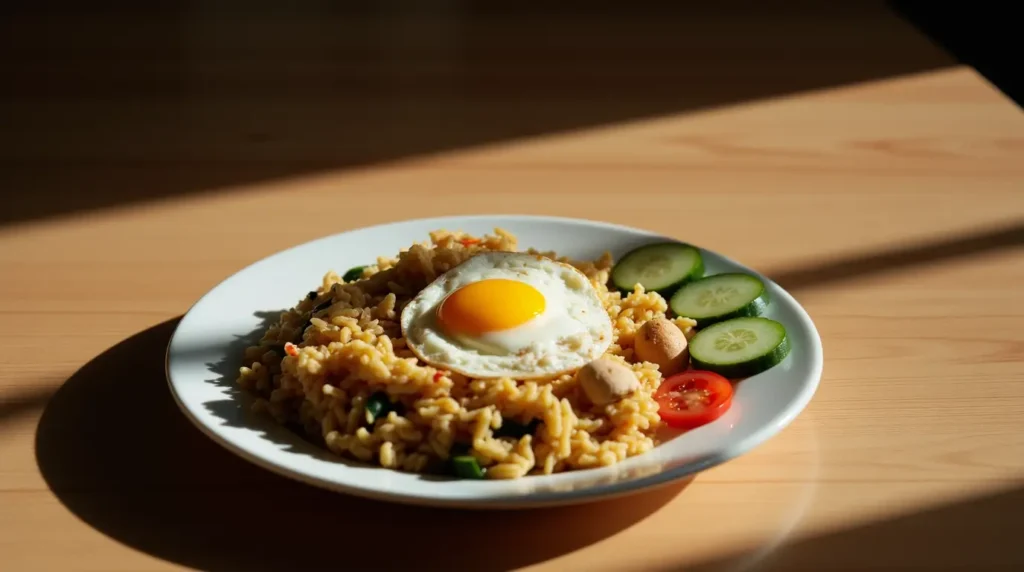
Arguably the most iconic dish in Indonesian Cuisine, nasi goreng is fried rice at its best. Typically made with leftover rice stir-fried with shallots, garlic, chilies, sweet soy sauce, and some form of protein (chicken, shrimp, or fried egg), it’s comfort food for Indonesians. This dish is so emblematic that it’s eaten any time of day—breakfast, lunch, or dinner.
- History & Characteristics: It’s believed to have been influenced by Chinese fried rice, adapted over centuries to incorporate Indonesian ingredients. The sweet-savory flavor from kecap manis sets it apart from other Asian fried rice variations.
- Recipe Tip: To recreate nasi goreng, use day-old rice for better texture and stir-fry with a mix of garlic, shallots, chili, and a splash of sweet soy sauce. Top with a fried egg and crispy fried shallots.
Rendang
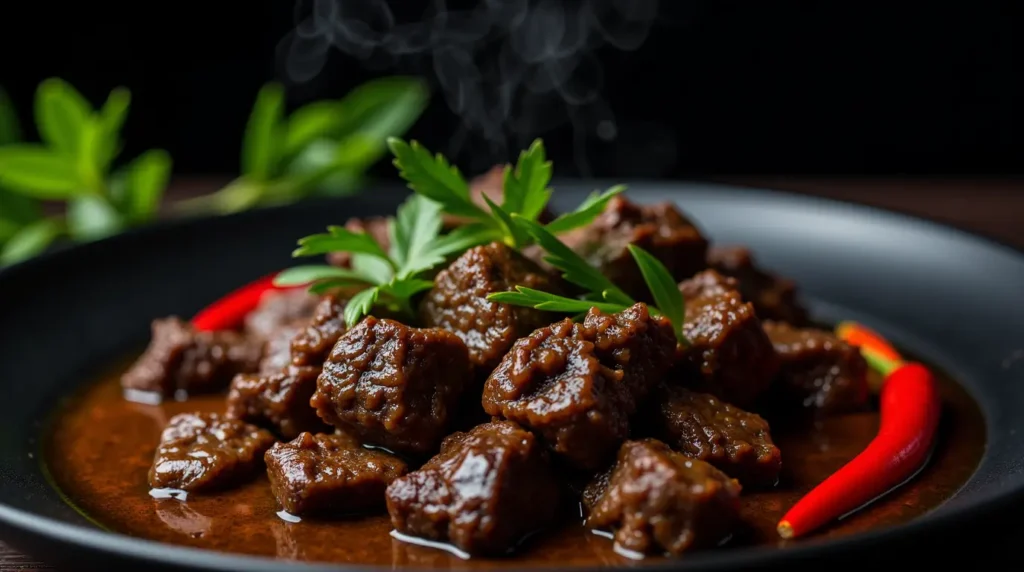
Hailing from the Minangkabau region in West Sumatra, rendang is one of the most celebrated dishes in Indonesian Cuisine. This slow-cooked beef stew is simmered in coconut milk and a complex spice paste, resulting in a dish that is rich, dark, and intensely flavored. Often served during festive occasions, such as weddings and Eid al-Fitr, rendang is a true labor of love that showcases Indonesia’s mastery of slow cooking and bold spices.
- History & Characteristics: Named one of the most delicious foods in the world by international culinary experts, rendang was originally devised as a way to preserve meat using spices, chilies, and coconut milk in an era without refrigeration.
- Recipe Tip: To make a simplified version at home, combine beef with coconut milk, onions, garlic, ginger, galangal, lemongrass, chili, and spices like coriander and turmeric. Simmer on low heat until the liquid has reduced, allowing the flavors to caramelize and intensify.
Satay (Sate)
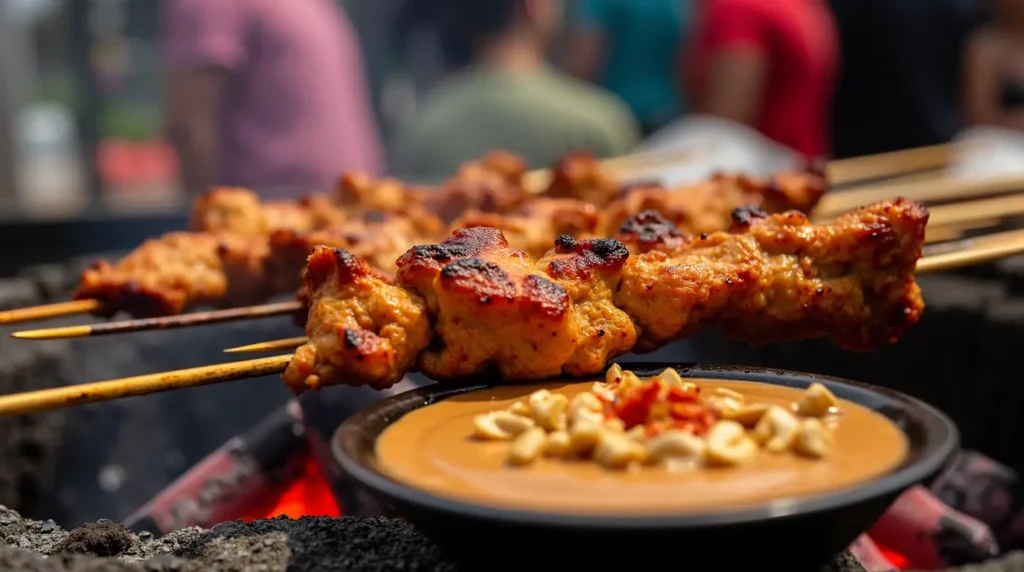
Satay is a street-food favorite throughout Southeast Asia, but it holds a special place in Indonesian Cuisine due to its incredible diversity. At its core, satay consists of marinated meat (chicken, beef, goat, fish, or even tofu) skewered and grilled over charcoal, then served with a spicy peanut sauce or a tangy soy sauce blend. Each region in Indonesia offers its own twist on satay, making it a versatile and beloved dish across the archipelago.
- History & Characteristics: The concept of skewered meat was influenced by Middle Eastern kebabs, adapted over time into Indonesia’s peanut sauce-laden version. Different regions boast their own unique takes. For example, Sate Padang from Sumatra features a thick, spicy sauce enriched with turmeric.
- Cooking Tip: Marinate the meat in a mixture of spices, sweet soy sauce, and a bit of oil. Grill until slightly charred. Serve with a homemade peanut sauce by blending roasted peanuts, garlic, chili, and a splash of sweet soy sauce.
Gado-Gado
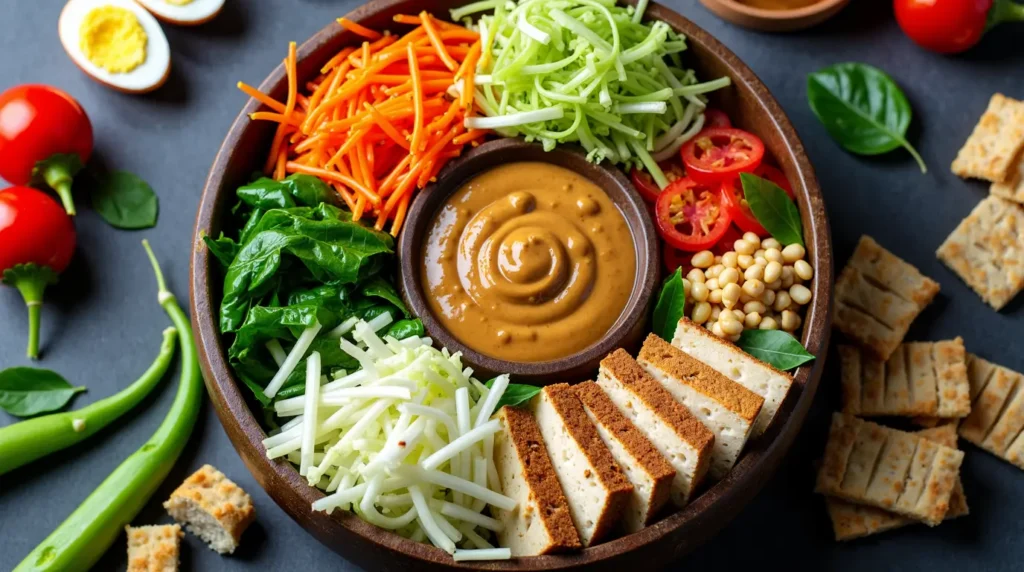
Gado-gado literally translates to “mix-mix” and is one of the most beloved Indonesian salads. It combines blanched or lightly steamed vegetables—like spinach, bean sprouts, and cabbage—with tofu or tempeh, sometimes boiled eggs, and is generously drizzled with a peanut dressing.
- History & Characteristics: Historically, this vegetable dish was a way to repurpose leftover produce in a single meal. Today, it’s commonly sold by street vendors and offers a healthier option in a cuisine known for its rich and spicy foods.
- Serving Tip: The peanut sauce can be sweet, spicy, or tangy, depending on the region. Top the salad with crispy shallots and prawn crackers (krupuk) for added texture.
Soto
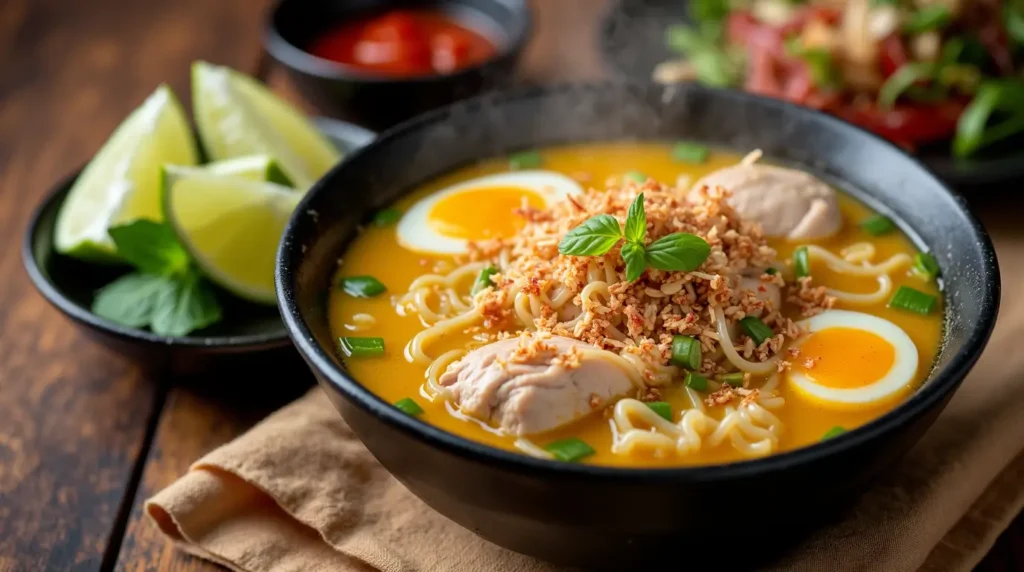
Soto is a category of soups that showcases the rich diversity of Indonesian Cuisine, with variations found across different regions. Common elements include a savory broth (chicken, beef, or goat), aromatic spices, and fresh herbs, creating a comforting and flavorful dish. One of the most universally recognized versions is Soto Ayam (chicken soto), known for its fragrant turmeric-infused broth and tender shredded chicken.
- History & Characteristics: Soto may trace its origins to Chinese-style broth soups, gradually localizing with indigenous spices like turmeric and lemongrass. Sometimes coconut milk is added for creaminess.
- Serving Tip: For a simple Soto Ayam, simmer chicken broth with turmeric, lemongrass, lime leaves, and garlic. Add shredded chicken, boiled eggs, and glass noodles. Garnish with fried shallots and a squeeze of lime.
These foundational dishes illustrate the heart and soul of Indonesian cuisine: layers of flavor, aromatic spices, and the creative use of local produce. In each region, you’ll find variations—for instance, Sate Madura (from Madura Island) has a distinctive sweet peanut sauce, while Nasi Goreng Kampung uses more chili to achieve a spicier twist.
Defining Characteristics of Indonesian Cuisine
Bold, Spicy, and Aromatic
Indonesian cuisine is widely celebrated for its robust, aromatic qualities. Layers of flavor are common, with the interplay between spicy chilies, sweet palm sugar, salty fish sauce, or shrimp paste, and tangy lime or tamarind forming a harmonious balance. While spiciness can be toned down, many Indonesian dishes rely on a good dose of chili heat to spark the taste buds.
Hearty, Comforting, and Communal
Meals are often served family-style, encouraging diners to sample multiple dishes together. Heaps of steaming white rice anchor the feast, accompanied by various side dishes: vegetables, meats, fish, and sambals for dipping. This communal aspect is reflective of Indonesia’s deep-rooted emphasis on family and social bonds.
Signature Flavor Combinations
- Sweet Soy Sauce + Chili: Commonly used for marinating grilled meats, this combo yields a sweet yet fiery profile.
- Coconut Milk + Spices: Found in dishes like rendang or various gulais (curries), lending richness and a silky texture.
- Peanut Sauce: Provides a nutty, savory dimension to grilled meats, salads, and even vegetable dishes.
For food enthusiasts who crave complexity in their meals, Indonesian cuisine offers a tantalizing array of tastes—from mouth-searingly spicy to decadently sweet—ensuring there’s always something new to discover.
Tips and Highlights to Encourage People to Try Indonesian Cuisine
- Exotic Yet Familiar: While Indonesian dishes might include exotic herbs and spices, the underlying flavor profiles—like sweet, salty, and spicy—are often comforting and recognizable. Anyone who appreciates curries, stir-fries, or grilled meat will find something they love.
- Variety for All Diets: Whether you’re an omnivore, pescatarian, or vegetarian, Indonesian cuisine can cater to your preference. Tempeh and tofu are ingrained in the food culture, offering substantial and delicious meatless options.
- Rich Cultural Stories: Many dishes have a compelling backstory—like rendang’s historical role as a celebratory dish or satay’s evolution through foreign influences. Discovering these narratives can heighten the enjoyment of the meal.
- Affordability and Accessibility: Street vendors and small local eateries (warungs) provide an affordable and authentic experience. For travelers, tasting local street food is one of the best ways to immerse in Indonesian culture.
- Easy at Home: Thanks to the growing availability of Indonesian spice pastes and ingredients in international markets, replicating dishes at home has never been more feasible. Once you master a few basic condiments and spice blends, you can create aromatic Indonesian meals in your own kitchen.
Table Rituals and Customs
Daily Meal Structure
- Breakfast: Often lighter, focusing on simple fried rice, noodles, or porridge (bubur ayam). Snacks like fried bananas (pisang goreng) might also appear in the morning routine.
- Lunch: Typically the main meal of the day. In offices and schools, nasi campur (a portion of rice with assorted side dishes) is popular because it’s quick, balanced, and budget-friendly.
- Dinner: Usually a family affair. A set of dishes—vegetables, protein, sambal—may be laid out, and everyone helps themselves.
Table Etiquette
- Sharing Dishes: Indonesians often eat from shared plates of communal dishes. Scooping small portions onto individual plates is the norm.
- Right Hand Usage: In many parts of the country, especially in more traditional or Muslim-majority areas, eating with the right hand (rather than the left) is considered polite. If you’re dining with your hands, be mindful of this cultural practice.
- Removing Shoes: In some households, it’s customary to remove your shoes before entering. Pay attention to local norms, especially in more traditional settings.
- Gestures to Avoid: Pointing at others with a fork or chopstick can be deemed rude. It’s also polite to wait for the eldest or host to begin eating before you start.
Festive and Religious Celebrations
- Eid al-Fitr (Lebaran or Idul Fitri): Marking the end of Ramadan, families gather to enjoy special dishes like ketupat (rice cakes wrapped in coconut leaves), opor ayam (chicken cooked in coconut milk), and various cookies.
- Christmas Celebrations (in Christian-majority areas): Celebrated widely in parts of Eastern Indonesia, featuring a mix of local classics and Western-inspired holiday foods. Dishes like babi panggang (roasted pork) are common in certain regions.
- Nyepi in Bali (Hindu New Year): A day of silence, fasting, and reflection. While feasting is not the highlight on the day itself, the days leading up to Nyepi can involve special ceremonial foods.
- Weddings and Family Gatherings: Often see grand spreads of elaborate dishes, from satay and rendang to layered rice tumpeng (the cone-shaped yellow rice tower).
These rituals and feasts highlight the communal essence of Indonesian Cuisine. Food is not merely sustenance; it serves as a means for socializing, celebrating, and preserving traditions across generations, reinforcing the deep cultural significance of every shared meal.
Modern Trends and Culinary Fusions
Global Influences and Fusion Cuisine
In big cities like Jakarta, Surabaya, and Bandung, modern Indonesian chefs are experimenting with global flavors. Western techniques meet Indonesian ingredients, leading to novel creations like sambal-flavored pasta or desserts infused with tropical fruits and spices. High-end restaurants may offer degustation menus that reinterpret classics like nasi goreng and soto in artful, contemporary presentations. This movement has further propelled Indonesian cuisine onto the international stage, appealing to foodies looking for an innovative twist on tradition.
New Consumption Trends
- Vegetarian and Vegan Options: As health and sustainability awareness grows, more restaurants offer vegetarian and vegan takes on staple dishes. Tempeh remains a hero ingredient, prepared in various ways to mimic the texture of meat.
- Farm-to-Table: Younger chefs are keen on highlighting locally grown produce, forging relationships with farmers and fishermen to emphasize freshness and quality. Organic produce is slowly becoming more accessible in urban markets.
- Health-Conscious Adaptations: Cooking methods are being adapted to reduce oil and sugar content, offering lighter versions of traditionally heavy dishes like opors and curries without compromising flavor.
Spotlight on Young Indonesian Chefs and Restaurateurs
Across Indonesia, a new wave of culinarians is revitalizing Indonesian Cuisine. Having traveled overseas for training, these chefs are integrating international techniques with their rich culinary heritage, creating innovative yet deeply rooted dishes. For example:
- Chef Mandif Warokka in Bali experiments with molecular gastronomy applied to Indonesian flavors, creating elaborate tasting menus.
- Chef Ragil Imam Wibowo in Jakarta focuses on preserving traditional recipes but elevates them with modern plating and sustainable sourcing.
These trendsetters not only breathe new life into classic dishes but also ensure that Indonesian cuisine continues to evolve while maintaining its identity. They serve as ambassadors, representing the country’s gastronomic potential to the global community.
Conclusion and Call to Action
Indonesian cuisine is an intricate tapestry of flavors, techniques, and cultural narratives. Shaped by centuries of trade, colonization, migration, and regional innovation, it stands as one of the most diverse culinary landscapes in the world. From the rich aromas of rendang to the irresistible smell of satay sizzling over hot coals, there is a dish for every palate—spicy or mild, meat-based or vegetarian, sweet or savory.
In this article, we explored:
- The Historical Context: Tracing influences from Indian, Chinese, Middle Eastern, and European culinary traditions.
- Key Ingredients and Local Products: Highlighting the spices, herbs, and condiments that underpin Indonesian food.
- Must-Try Dishes: Giving you a starting point with classics like nasi goreng, rendang, and satay.
- Defining Characteristics: Understanding Indonesian cuisine’s bold, communal, and deeply aromatic nature.
- Dining Etiquette and Customs: Shedding light on the cultural values and social dynamics at the Indonesian table.
- Modern Trends and Fusion: Discussing how local chefs are merging global influences with time-honored recipes.
Now it’s your turn to explore. Have you tried any Indonesian dishes before? Share your thoughts, favorite recipes, or even cooking challenges you’ve faced. If you have any burning questions or stories to tell, we’d love to hear about them. For those new to Indonesian cuisine, consider starting with something simple like nasi goreng—it’s easy to make, uses widely available ingredients, and captures the essence of sweet and savory flavors that define Indonesian food.
Looking ahead, there’s still so much more to discover. In a future article, we could delve deeper into Indonesia’s array of sambals—the many chili sauces and condiments that vary from region to region, each with its own unique flavor profile. Until then, embrace the spirit of adventure and dig into the bold tastes of this archipelago. You may just find a new favorite cuisine that speaks not only to your taste buds but also to your sense of culinary curiosity.
Selamat makan—enjoy your meal!

